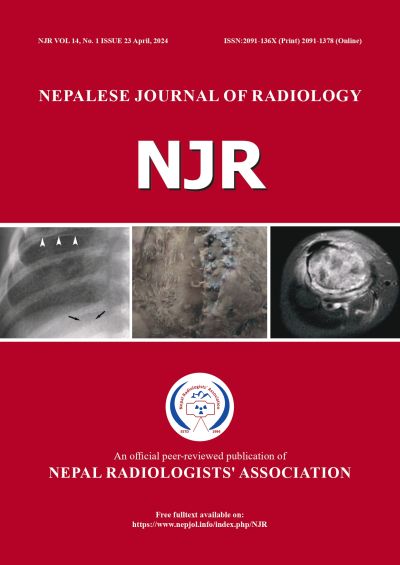Evaluation of the Thickness of Ligamentum Flavum at the Level of Lumbosacral Spine (L4-L5, L5-S1) and its Relationship with Degenerative Disc Changes in Patients Undergoing MRI of Lumbosacral Spine
DOI:
https://doi.org/10.3126/njr.v14i1.64626Keywords:
Magnetic Resonance Imaging, Ligamentum Flavum, Low Back PainAbstract
Introduction: Low back pain (LBP) is a very common cause of disability in working-age adults; with degenerative changes being the predominant cause apart from anatomical factors. Degenerative changes in the lumbar spine are associated with the alteration of the thickness of the Ligamentum Flavum (LF), which predisposes to clinical symptoms.
Methods: This was a prospective study conducted among ninety symptomatic (LBP) patients who underwent magnetic resonance imaging (MRI) and the images were evaluated to measure the thickness of the LF and evaluate the degree of disc degeneration by the Pfirrmann grading system, according to the spinal levels (L4-L5, L5-S1). An association was sought between LF hypertrophy and disc degeneration, age, sex, and disc height.
Results: The result of this study showed that with increasing age thickening of the LF could lead to degeneration of the intervertebral disc. Thickening of the LF was more at the level of L4-L5 level than at the L5-S1 level with right-sided increased thickness more than on the left and is associated with increased grade of disc degeneration. Females had slightly more thickened LF than the males at the L4-L5 level with no gender predominance at the L5-S1 level.
Conclusions: Thickening of the ligamentum flavum may be an important factor in the origin of LBP, especially in the adult population. A degenerative process in the ligamentum flavum that occurs with age and also suggests the thickening of LF due to mechanical stress at the lumbar level would ultimately result in degeneration of the disc.
Downloads
Downloads
Published
How to Cite
Issue
Section
License
Copyright (c) 2024 Nepalese Journal of Radiology

This work is licensed under a Creative Commons Attribution-NonCommercial 4.0 International License.
This license enables reusers to distribute, remix, adapt, and build upon the material in any medium or format, so long as attribution is given to the creator. The license allows for commercial use.




